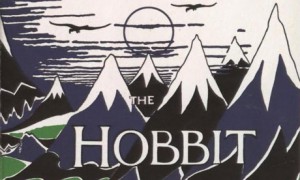 In our newest TORn Library feature, Brian Tither discusses the effectiveness of portraying Tolkiens’ story-telling via cinematography.
In our newest TORn Library feature, Brian Tither discusses the effectiveness of portraying Tolkiens’ story-telling via cinematography.
Continue reading “The potential of JRR Tolkien’s story-telling in The Hobbit movies”
In our newest TORn Library feature, Brian Tither discusses the effectiveness of portraying Tolkiens’ story-telling via cinematography.
Continue Reading In our newest TORn Library feature, Brian Tither discusses the effectiveness of portraying Tolkiens’ story-telling via cinematography.
In our newest TORn Library feature, Brian Tither discusses the effectiveness of portraying Tolkiens’ story-telling via cinematography.
Continue reading “The potential of JRR Tolkien’s story-telling in The Hobbit movies”
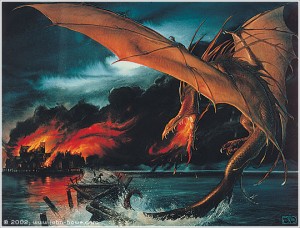
A lot of folks have — in the wake of the trailers for The Desolation of Smaug — been pondering the question about the number of legs our favourite big, bad beastie might possess in the estimation of Peter Jackson (and his conceptual artists Alan Lee and John Howe).
Four? Two? It seems to be a bit unclear.
Here, Ringer Arandir examines the evidence (he does say that it’s not movie spoilery, but I think it is a little bit, so here’s your warning) and posits that we may be seeing a mid-stream change in Smaug’s conceptual design. Continue reading “Dragons vs wyverns: the question of Smaug”
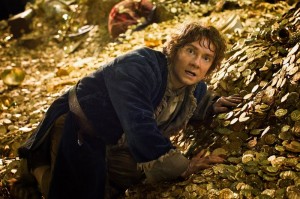 If you’ve seen much of the various bits of footage of Smaug’s hoard, you’ll have gotten the feeling that Smaug’s hoard is pretty large. Over on Wired, Rhett Allain has attempted to use algebra to calculate the size (and modern worth) of Smaug’s hoard.
If you’ve seen much of the various bits of footage of Smaug’s hoard, you’ll have gotten the feeling that Smaug’s hoard is pretty large. Over on Wired, Rhett Allain has attempted to use algebra to calculate the size (and modern worth) of Smaug’s hoard.
It’s a valiant attempt, but having seen more of the hoard shown on screen at the Fan Event, I think he underestimates the vastness of Smaug’s hoard. I have to emphasise that it is simply immense, spanning the breadth and length of the entire throne room in several mountainous mounds.
Factoid: the amount of mined gold estimated to exist in the world today in total is put at a cube roughly 25 metres (about 82 feet) on each size. Smaug’s hoard, as Wired estimates it, is far larger — 158 cubic metres!
Now I know this is just a fantasy worlds, but that must mean that the total amount of gold in Middle-earth must be simply enormous. Consider the even-vaster wealth of Moria, long since looted by Orcs. Yes, the “wealth of Mora was not in gold or jewels”, yet they must have had a great store of it even if obtained through trade. The Dwarven mines of the Grey Mountains were also fruitful, until the dragons came, and the wealth of Gondor even in its waning must have been substantial. Where is all this wealth? Was much of it lost to the peoples of Middle-earth through wars, buried deep (such as Moria’s lower treasuries) or simply hoarded by Sauron?
If it wasn’t, such an immense amount of gold would surely dilute its real value. After all, the value of these things is in proportion to their scarcity. The more common gold is, the less its value (this is why de Beers used to hoard its diamonds). Certainly the Lake-folk in The Hobbit speak of rivers of gold once flowing from the Mountain but that’s metaphor … and possibly a bit of handed-down exaggeration.
I guess dragons love gold. In the recent trailers for The Hobbit: The Desolation of Smaug (YouTube clip) you can get a glimpse of all the gold Smaug has. Why does a dragon need this much gold? I don’t get it. Maybe Smaug doesn’t actually like gold but he just wants to keep it away from other people.
Whatever his motivation for hoarding, I am going to try to get an estimate for just how much gold is in the Lonely Mountain.
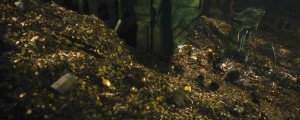 This is the hardest part. How big is the dragon? How big is a hobbit? We need some value here. My original plan was to look at a section of the trailer that shows gold pieces flying through the air. If I measure the acceleration of one piece of gold as it falls, I can assume that it has Earth-like acceleration of 9.8 m/s2. From this, I could find the scale of something in the scene.
This is the hardest part. How big is the dragon? How big is a hobbit? We need some value here. My original plan was to look at a section of the trailer that shows gold pieces flying through the air. If I measure the acceleration of one piece of gold as it falls, I can assume that it has Earth-like acceleration of 9.8 m/s2. From this, I could find the scale of something in the scene.
Well, that didn’t work out too well. Instead, I am just going with plain estimations. Here is a shot of Bilbo sliding down a pile of gold.
I previously estimated that a hobbit was about 1.3 meters tall. That would put this gold hill with a slope side at least 5 meters long inclined at 20 degrees above the horizontal. I think that actually, this gold pile might even be much larger than this estimate.
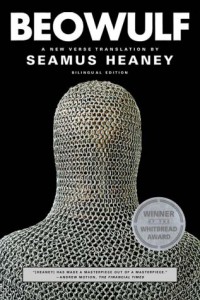 The opening line ‘Listen!’ is not a proclamation and should not have an exclamation mark, according to new research by an academic at the University of Manchester.
The opening line ‘Listen!’ is not a proclamation and should not have an exclamation mark, according to new research by an academic at the University of Manchester.
It is perhaps the most important word in one of the greatest and most famous sentences in the history of the English language.
Yet for more than two centuries “hwæt” has been misrepresented as an attention-grabbing latter-day “yo!” designed to capture the interest of its intended Anglo-Saxon audience urging them to sit down and listen up to the exploits of the heroic monster-slayer Beowulf.
According to an academic at the University of Manchester, however, the accepted definition of the opening line of the epic poem – including the most recent translation by the late Seamus Heaney – has been subtly wide of the mark. Continue reading “Listen! Beowulf opening line misinterpreted for 200 years?”

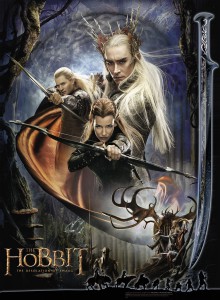 WELLINGTON, New Zealand — Those outside of the movie making business often don’t understand what The Producer does on a film. The quickest answer is: They get the movie made. They get things done.
WELLINGTON, New Zealand — Those outside of the movie making business often don’t understand what The Producer does on a film. The quickest answer is: They get the movie made. They get things done.
In the case of Zane Weiner on “The Hobbit,” it meant getting in touch with someone nobody was meant to get in touch with.
Evangeline Lilly.
Living in Hawaii, she was a month removed from the birth of her child, email turned off, not taking calls about work and still confined to bed rest.
“So I was still in bed with the baby,” she told TheOneRing.net in full Tauriel outfit and gear during a lunch break on a full day of filming on “The Hobbit.”
This lunch tent, while perhaps not glamorous, is an essential part of Stone Street Studios and making Peter Jackson movies, designed to feed and shelter quite an enormous crowd. Breakfast was served there for anybody wanting to start the day off right. Coffee and tea were available on any sound stage but also in the tent — a first stop for many on a shoot. Continue reading “Evangeline Lilly gets personal with TORn about Tauriel and ‘The Hobbit: The Desolation of Smaug’”
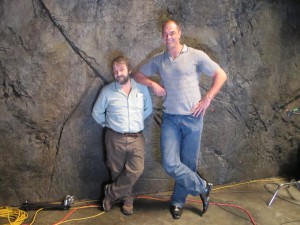 Over the last few weeks I’ve had the pleasure of chatting with the wonderful Conan Stevens (Bolg) about his life and career.
Over the last few weeks I’ve had the pleasure of chatting with the wonderful Conan Stevens (Bolg) about his life and career.